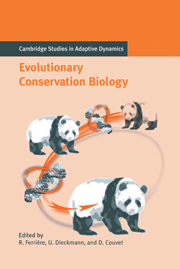Book contents
- Frontmatter
- Contents
- Contributing Authors
- Acknowledgments
- Notational Standards
- 1 Introduction
- Part A Theory of Extinction
- Part B The Pace of Adaptive Responses to Environmental Change
- 5 Responses to Environmental Change: Adaptation or Extinction
- 6 Empirical Evidence for Rapid Evolution
- 7 Genetic Variability and Life-history Evolution
- 8 Environmental Stress and Quantitative Genetic Variation
- Part C Genetic and Ecological Bases of Adaptive Responses
- Part D Spatial Structure
- Part E Community Structure
- References
- Index
- The International Institute for Applied Systems Analysis
8 - Environmental Stress and Quantitative Genetic Variation
Published online by Cambridge University Press: 15 August 2009
- Frontmatter
- Contents
- Contributing Authors
- Acknowledgments
- Notational Standards
- 1 Introduction
- Part A Theory of Extinction
- Part B The Pace of Adaptive Responses to Environmental Change
- 5 Responses to Environmental Change: Adaptation or Extinction
- 6 Empirical Evidence for Rapid Evolution
- 7 Genetic Variability and Life-history Evolution
- 8 Environmental Stress and Quantitative Genetic Variation
- Part C Genetic and Ecological Bases of Adaptive Responses
- Part D Spatial Structure
- Part E Community Structure
- References
- Index
- The International Institute for Applied Systems Analysis
Summary
Introduction
Exposure to environmental stress is a common feature in the life of most natural populations of plants and animals that live in the wild. Primarily, this is because natural populations inhabit environments that are heterogeneous in space and constantly change in time; some of these changes are bound to be hostile. Numerous factors impose stress on living organisms. Not only catastrophic events, such as earthquakes, floods, and fires, but also many less extreme environmental shifts experienced by organisms may be stressful for them. The nature of these stresses can be abiotic (e.g., climatic changes, reduction in food resources) or biotic (e.g., overpopulation, invasion of novel parasites or predators). In addition to environmental stressors that are part of their “natural” environment, in the twentieth century plant and animal populations faced human-related challenges that had previously never been encountered by them throughout their evolutionary history. Loss and deterioration of natural habitats because of land-clearing for agricultural and urbanization purposes, global warming, and environmental pollution are the main threatening ecological hazards created by human activity. It appears that organisms live in a world full of stress and the ability to cope with it is of crucial significance to their persistence.
The consequences of stress exposure are obviously relevant to conservation biology. By definition, stress has a detrimental effect on population fitness, that is the ability of a population to survive and reproduce.
- Type
- Chapter
- Information
- Evolutionary Conservation Biology , pp. 136 - 150Publisher: Cambridge University PressPrint publication year: 2004



